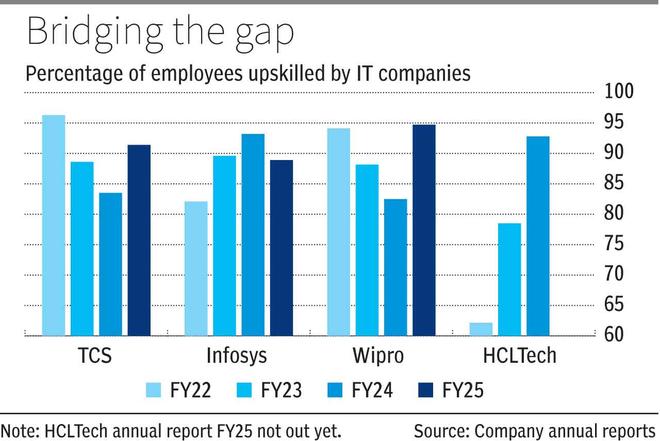
Analysts note that Indian IT industry is upskilling talent in their own ways through digital training modules, classroom sessions, fresher trainings and the like, but it may not be sufficient today to meet client and market expectations
| Photo Credit:
iStockphoto
Even as top-tier IT companies declare in their annual reports that they have upskilled over 90 per cent of their employees in the recent fiscal year, redeployment of talent continues to be a challenge, as indicated by the recent TCS layoffs.
Analysts note a disconnect between the nature of skilling initiatives undertaken by Indian IT players and the real world demands, especially for mid-level talent.
TCS, while announcing its layoffs, stated that it will be “releasing associates from the organisation whose deployment may not be feasible.” The CEO also noted that the job cuts relate to the skills gap. However, the annual report disclosures of the IT firms paint a different picture.

In FY25, TCS noted that over 91 per cent of their 6 lakh+ employees were upskilled. This metric was at 89 per cent for Infosys and 95 per cent for Wipro. HCL Tech’s recent disclosures for FY24 show that 93 per cent of its employees underwent upskilling during the fiscal year. Cognizant, being a US-based company, does not disclose similar data.
TCS has the highest average learning hours per employee per year at 96.4 hours in FY25; however, this metric is lower for their mid-level staff, at just 61 hours per employee.
Analysts note that the Indian IT industry is upskilling its talent in various ways through digital training modules, classroom sessions, and fresher training, among others, but this may not be sufficient today to meet client and market expectations.
“Trainings cannot be a substitute for deployment/delivery experience in a live environment,” said Jang Bahadur Singh, Associate Partner, Talent Solutions, India, Aon. “IT services pyramids are built baking in billability of capability – if someone transitions into a completely new skill as a beginner, the bill rate will not support the cost of the individual, so any mis-match between the role and capability leads to redeployment issues,” Singh added.
Pushkar Bidwai, CEO of People Matters, notes that given the pace at which business needs evolve, the skills employees are trained in today may not fully match the project demands of tomorrow, particularly when niche tech stacks are involved. “The middle layer is tricky. These are experienced folks who’ve delivered consistently, but now need to evolve with the pace of tech. The usual classroom-style or certification-led learning doesn’t cut it, and targeted, project-led skilling works better,” he said.
Middle layer
Kanchana Krithivasan, Senior Director, Human Resources at ADP India, said the middle layer, which typically consists of experienced managers, tech leads and domain experts, is the backbone of technology companies. “The right way to upskill or reskill this middle layer is to combine role-specific learning, real-world exposure and mindset transformation, ensuring they can lead change rather than just adapt to it,” she said.
However, another HR consultant noted that the agility required to pivot to a new skill does not come naturally to this portion of the population, making upskilling particularly challenging for mid- to senior-level talent.
More Like This
Published on July 29, 2025

